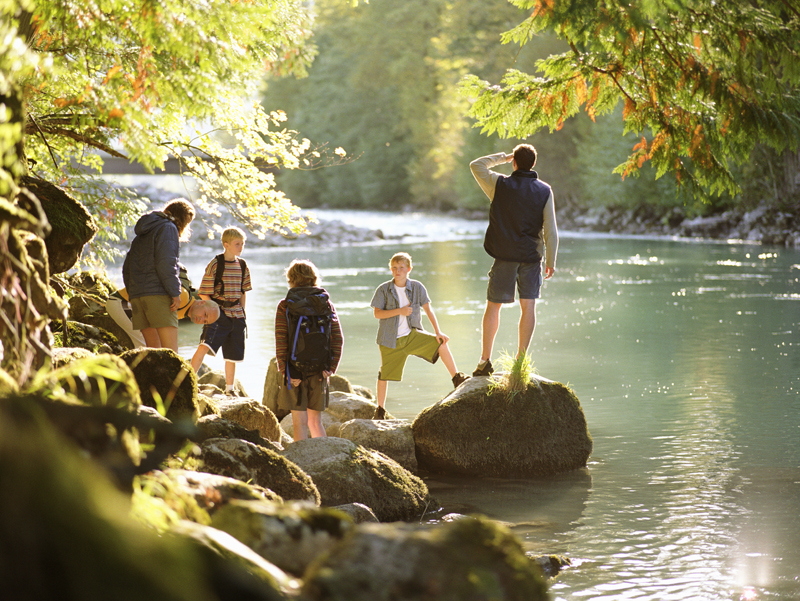Written by Heather McGinley
Although it may be difficult to plan a vacation in the present economy, exciting travel destinations are more accessible than you might think.
If you want to vacation on a dime, or if work responsibilities leave you short on time, drivable vacation destinations exist all across Virginia—for couples, individuals and families.
Below are four fantastic trips that you can take in a day, saving you time and money.
1. Windsor Castle & Downtown Smithfield
Dedicated in May of 2010, Windsor Castle Park, located in downtown Smithfield, provides scenic walking and running trails with a separate trail for bikers.
Walkers and runners can see the Smithfield Station inn and restaurant emerge from behind the trees as they cross wooden bridges, connecting portions of the trail and linking the trail to the city. Visitors can view the “castle”—a plantation house once inhabited by Arthur Smith, Smithfield’s founder—from the trail or deviate from the path for a closer look.
Photographers can be seen snapping pictures in front of the weathered barn structures that surround the plantation adjacent to the beach cove created by the Pagan River. The Smithfield Center rents the “castle” area for special events.
Visitors can park nearby and launch kayaks and canoes into the river from a state-of-the-art launch area and row miles of waterways. There are also designated areas where visitors can park and fish off piers.
Want to spend the day with family, friends or Fido?
There are grilling areas, picnic tables, a playground area, Porto johns and hand washing stations. The facility also has a sizable dog park. Visitors must register with Smithfield ahead of time to gain access to the dog park. A one-day pass costs $2 per dog, and a special code is required for access.
While in Smithfield, Main Street, known for its old buildings, antique shops and old-fashioned dining spots, is just five minutes away.
2. The Dismal Swamp Canal Trail & National Wildlife Refuge
For those seeking outdoor adventure and ways to get in touch with nature, the Dismal Swamp Canal Trail on the Great Dismal Swamp National Wildlife Refuge offers a number of opportunities. The Great Dismal Swamp has entrances and trails in Chesapeake, Suffolk and North Carolina; but the Dismal Swamp Canal Trail, created from a portion of what used to be Route 17, is the only 8.5-mile paved trail. Beginning at the intersection of Dominion Boulevard and Old Route 17 in Chesapeake, the trail is open to walkers, runners, bikers and horse riders while the canal itself is open to kayakers, rowers and boaters.
Many visit the refuge and its trails to enjoy bird and butterfly watching, observe the unique swamp vegetation, fish in designated areas, picnic, participate in festivals and athletic happenings, and learn through educational events hosted by the refuge staff.
Now, about the wildlife.
Over 57 species of butterflies reside in the swamp alongside a variety of mammals including bats, otters, minks, red and grey foxes, white-tailed deer, American black bears and bobcats.
Bird watchers have identified over 200 species on the refuge including swans, herons, egrets, eagles, cuckoos, owls, hummingbirds, wrens, tanagers, orioles and over 35 species of warblers.
An assortment of reptiles and amphibians also reside on the refuge, including lizards, salamanders, toads, frogs, snakes and turtles. The refuge was established in 1974 to protect and manage the wildlife and habitat of more than 110,000 acres of swamp extending into North Carolina.
Historically significant, people have been living in and around the swamp for
at least 13,000 years. In 1650, Native Americans and some European settlers resided in the swamp. Years later, George Washington’s company surveyed portions of the swamp and created
a headquarters there.
The swamp also served as refuge for runaway slaves traveling along the Underground Railroad.
3. Maymont Park & Carytown
Maymont Park, a gift to the city of Richmond from James and Sallie Dooley, who lived there from 1893 to 1925, features gardens, wildlife exhibits, a petting zoo, a nature center, ponds, trails, a mansion which is open for tours during certain times of the year, and other structures.
Maymont has more than 10 distinctive gardens, some of which Sallie Dooley, an avid horticulture student, developed. There is a Japanese
Garden, an Italian Garden, an Arboretum, a cactus garden, a daylily and daffodil display garden, a butterfly garden, a via florum garden and more.
Visitors to Maymont Park enjoy biking, walking and jogging; observing bears, bison, foxes and birds of prey in their designated exhibit areas; petting farm animals; watching plays and concerts; participating in activities hosted by the park staff and community members; and relaxing or playing games in the expansive lawn areas.
After exploring the 100 acres of Maymont Park, visitors can shop and dine in nearby Carytown, which features unique and international dining options, wine bars, homemade ice cream and more. The shopping district includes specialty stores with international wares, trinkets, specialty toys, furniture and carpet, books, running paraphernalia, contemporary clothing as well as retro-themed clothing and accessories.
4. Luray Caverns
Want to travel a little further from home?
The Luray Caverns in Luray, Va., are a natural wonder. Discovered in 1878, the caverns are internationally known and are the largest in the eastern United States.
Visitors can explore the ancient caverns (they date back four million centuries) with a guide who explains the history and science behind stalactite and stalagmite formations while pointing out curious shapes in rock formations.
During the hour-long tour, visitors view Saracen’s Tent, a drapery structure formed from rock that seems hand folded and parted to create an entryway. Dream Lake, a shallow yet extensive body of water, is so still that it reflects ceiling formations like a mirror.
In the Cathedral—one of the largest rooms of the cavern—visitors can hear an automated performance on the Great Stalacpipe Organ, the largest musical instrument in the world, which uses rubber mallets to tap stalactites as far out as 3.5 acres into the cavern, producing symphonic quality tones.
After ascending the cavern stairs, visit the Car and Carriage Caravan Museum. Established in the 1950s, it contains hundreds of items related to transportation history (dating back to 1725), including carriages, cars, period costumes
and more.
Dedicated in 2010, the Luray Valley Museum, across from the welcome center, explores the history and culture of the Shenandoah Valley with displays featuring Native American artifacts, the religious and European roots of early settlers, the occupations and home life of residents throughout the region’s history, rifles, mining instruments and more.
Behind and beside the Luray Valley Museum, visitors can view or tour buildings representing the 19th century history of the area including a blacksmith and wagon repair shop, a church, a regular school, farm structures and a water tower labeled Stonyman Mining Company.
Children and adults can purchase a bag with mystery materials from Luray Valley Museum gift shop and mine for rocks, metals and other treasures under the water tower in basins created for that purpose.
After searching for treasure, visitors can use their puzzle-solving skills to navigate the one-acre ornamental Garden Maze. Eight-foot-tall hedges form the walls of the maze, which features hidden tunnels, fountains, a lookout tower and misting systems with special effects.
Admission to the caverns is $24 for adults, $12 for children (ages of 6 to 12) and $21 for seniors 62 years of age and older. Children ages five and younger are free when accompanied by a parent or guardian. Admission includes self-guided tours in the Car and Carriage Caravan and the Luray Valley Museum. Admission to the Garden Maze is $7 for adults and $6 for children ages 6 to 12.


